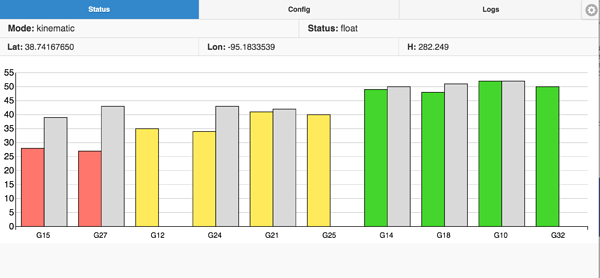I am having trouble getting good satellite on my reach rover. Do you have some good recommendations for improving the signal level performance? I am typically in “float” mode and very seldom ever go into “Fix” mode. I do have a thin metal ground plan. It is about. 4"x6". Should this be bigger? I saw someone say it should be copper, yes/no?
What about the placement of the reach board and the battery, wifi antenna, etc. Does any of this matter?
Any design tips would be helpful. I would really like to get it to operate in fix mode.
Hi!
What is the baseline length to your ntrip service provider?
Well that NTRIP server is about 100 km away. Would it be better to just use another reach module as the base? Then it would only be 1 km
L1 RTK baseline is limited and should not be more than 10 km. This is the main reason you are not getting fix status.
Unless your NTRIP provider supports virtual reference station mode(then you should set Transmit NMEA GPGGA messages to Base station to single), you should use your second Reach as a base station.
10km limit, is that because of L1/l2 ? or what causes this?
I know from previous use with ntrip providers, that closest local base is more than 20km away, and ntrip base up to 70km. And ususally no problem getting fix
L1 works on shorter baselines compared to L1/L2, 10km is not a hard limit, it is empirically determined distance after which you will see lower fix rate.
I can understand the use of radios, but as long as you have cell coverage of some sort (edge/2g etc), isnt ntrip correction via internet a better/easier way to work? Set up you own base with mobile router with lte modem and use your phone on location with shares internet. If you have a mobile accespoint, you could set up a RTK network anywhere and dont have to worry about radiolink and bad receptions. Of course, there will be times when radio works better.
But overall in areas with phone coverage…
As an Reach RTK novice, I am having similar issues. I use a RFD900+ radio link between a Reach Base and Rover. I can’t find an NTRIP provider in my area unfortunately (within 10Km). I am concerned that I’m getting some sort of bleedover between the RFD and my Antenna’s. I invested in some TW3710s on the advice of another forum and although I seem to be getting better reception with them, it just won’t come out of float. I sat for an hour with them last night waiting! If you all don’t mind, Ill list what I am doing so you can advise me if I can do better:
-
Testing is taking place in an open area with no obstacles within the sat paths.
-
Ground plane is 30cm x 30cm x 1mm Steel plate (Zinc galvanised)
-
RFD 900+ are about 10cm under the groundplate on a converted camera tripod. Antenna on top obviously…
-
I’m using the default settings with GPS at 10hz.
-
The base Reach is sat on a local geodetic survey mark so I’m confident the base coordinates are accurate.
I typically have 5-6 matched satellites above 45 SNR.
- Despite this, accuracy in float seems to hold well. RTKLIB Plot is showing its divergence at less than 5cm typically. Fix still alludes me though. Help!
Hi Adam!
Could you please check with corrections over TCP or serial? Maybe there are some packet losses in the radios and that prevents you from getting a fixed solution. You can also check the integrity of corrections data by downloading correction log in RINEX format and plotting the observations in RTKPlot.
Thanks for getting back to me Igor,
I was monitoring the corrections through RTKPlot in realtime and they looked satisfactory, although continually in float. Is there any way to post-process the rinex to get them more accurate?
I have struggled to set up a TCP connection between my base station and rover. Ideally I would like to have them both connected over 2 4G LTE Wifi hotspots. I have tried this but it didnt work… Do you have any guidance on how I can do that?
Adam
Hi Adam,
You can postprocess RINEX using RTKPost.
Please start a dedicated thread with details of your setup and we will try to help you get the hotspots running.





